Commonly disregarded for their long scale relatives in the bass family, I consider short scale basses to be some of the coolest instruments out there. People would usually go for a longer and bigger bass but let me tell you, these little basses pack quite a punch so don’t be fooled by their size and appearance.
A regular bass guitar is designed to have a longer body and a heavier weight. Unfortunately, those design characteristics are why some people may be turned off from learning the bass guitar. The short scale bass guitar has its distinctive charms to offer. The shorter scale makes it easier for you to tune and play. Specifically, for people with shorter hands and beginner players that are younger, it’s a blessing.
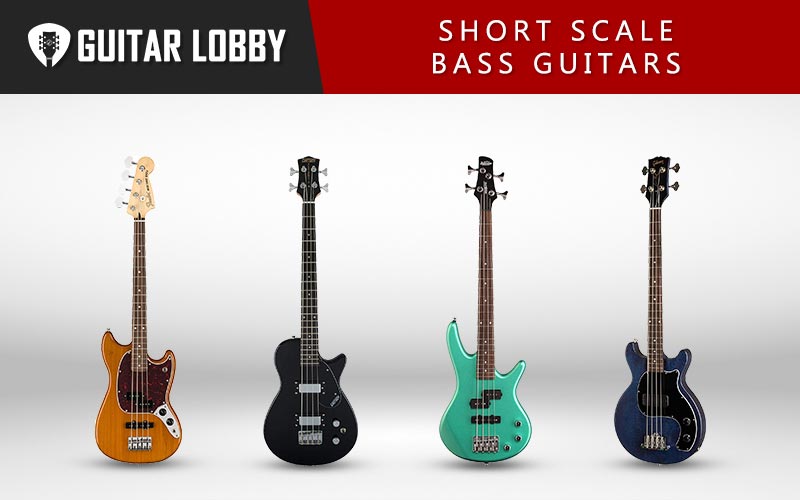
So what does a short scale bass offer except for better playability for people with shorter hands? While it is smaller and easier to play short scale basses can also produce peculiar tones that are different from what you may expect from standard scale-length bass guitars.
I’ll start this article by jumping into reviews on some of the best short scale bass guitars at each price point, but if you want to learn more about them before reading reviews, check out our buying guide at the bottom of the page.
| Name of Product | Image of Product | Description | Price Range | Full Review |
|---|---|---|---|---|
| 1. Ibanez GSRM20 Micro (Budget Pick) | 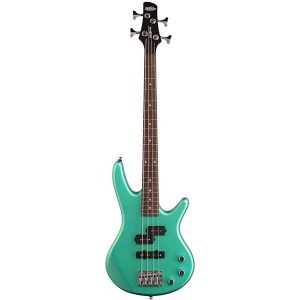 | Materials: Agathis body, maple neck Fretboard: Rosewood, 22 frets | $200 | Read Full Review Below |
| 2. Ibanez GSRM25 (Best 5 String) | 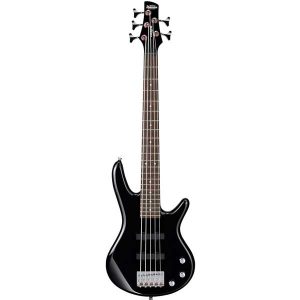 | Materials: Poplar body, maple neck Fretboard: Jatoba, 22 medium-jumbo frets | $200 | Read Full Review Below |
| 3. Fender Mustang PJ (Best Value) | 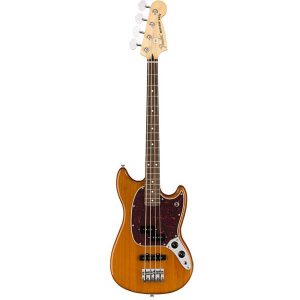 | Materials: Alder body, maple neck Fretboard: Pau Ferro | $750 | Read Full Review Below |
| 4. Lakland Skyline Hollowbody-30 (Editor's Choice) | 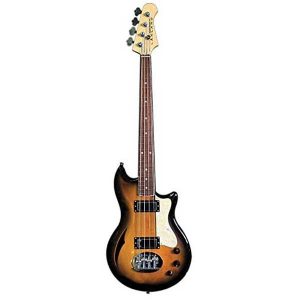 | Materials: Carved Mahogany back and sides with a carved Maple top, maple neck Fretboard: Pau Ferro, 20 frets | $1210 | Read Full Review Below |
| 5. Gibson Les Paul Junior Tribute DC (Best Under $1000) | 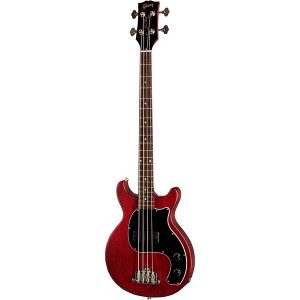 | Materials: Mahogany body, maple neck Fretboard: Rosewood | $1000 | Read Full Review Below |
| 6. Gretsch G2220 Junior Jet II (Best Under $500) | 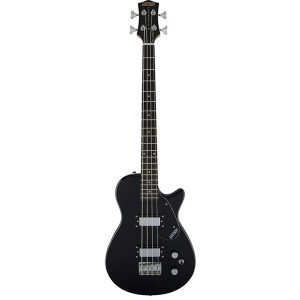 | Materials: Basswood body, maple neck Fretboard: Rosewood, 20 medium-jumbo frets | $300 | Read Full Review Below |
| 7. Epiphone EB-0 (Budget Pick) | 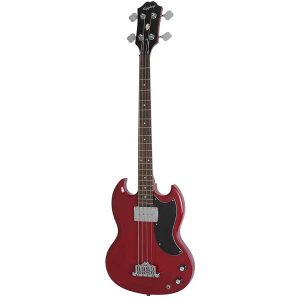 | Materials: Mahogany body/neck Fretboard: Rosewood | $270 | Read Full Review Below |
| 8. Eastwood Airline Map | 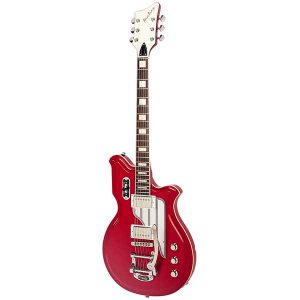 | Materials: Mahogany body, maple neck Fretboard: Rosewood | $1000 | Read Full Review Below |
| 9. Dean EVO XM Bass | 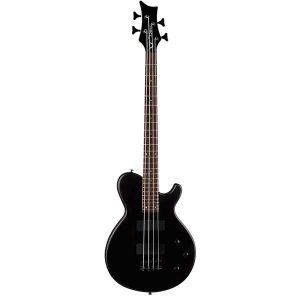 | Materials: Mahogany body, maple neck Fretboard: Walnut | $220 | Read Full Review Below |
| 10. Jackson JS1X Concert Bass Minion | 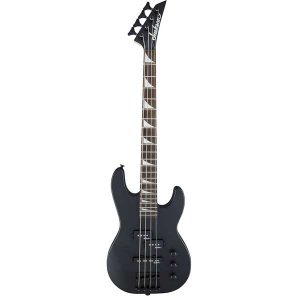 | Materials: Mahogany body, maple neck Fretboard: Walnut, 22 jumbo frets | $200 | Read Full Review Below |
| 11. Squier by Fender Bronco Bass | 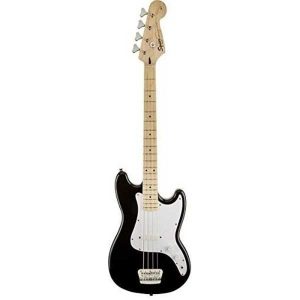 | Materials: Agathis body, maple neck Fretboard: Maple, 19 frets | $200 | Read Full Review Below |
| 12. Danelectro Longhorn | 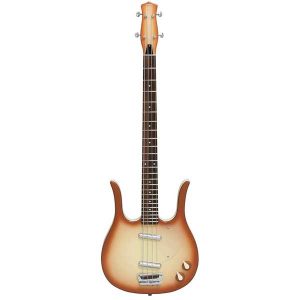 | Materials: Alder body, maple neck Fretboard: Pau Ferro, 24 frets | $570 | Read Full Review Below |
| 13. Dean Edge E09M | 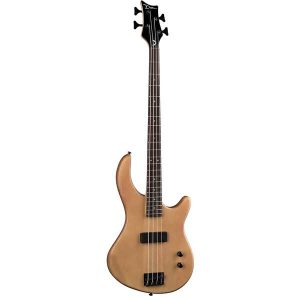 | Materials: Basswood/mahogany body, maple neck Fretboard: Rosewood, 22 frets | $200 | Read Full Review Below |
| 14. Hofner Ignition Series Violin Bass | 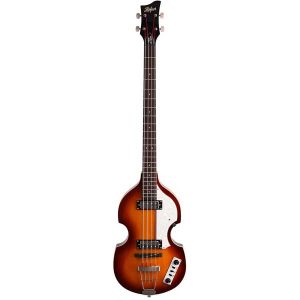 | Materials: Alder body, maple neck Fretboard: Pau Ferro, 24 frets | $300 | Read Full Review Below |
Here Are the Best Short Scale Bass Guitars
1. Ibanez GSRM20 Micro (Budget Pick)
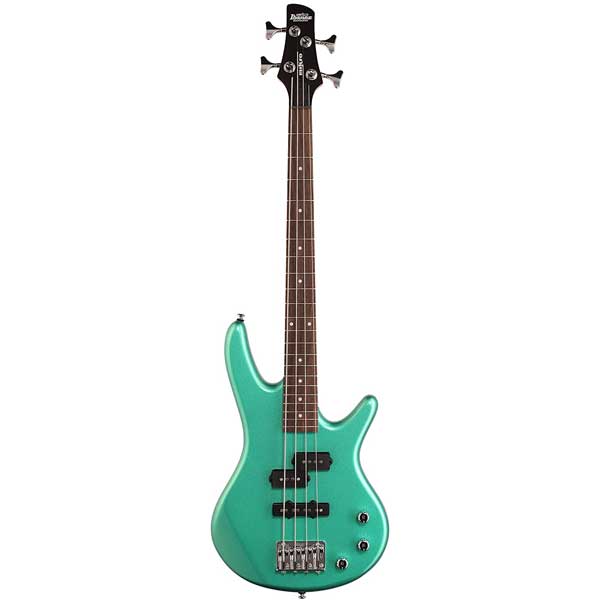
| Estimated Price | $200 |
| Materials | Agathis body, maple neck |
| Fretboard | Rosewood, 22 frets |
| Pickup Configuration | Split-coil, single-coil |
| Scale Length | 28” |
My Review: What stands out about this bass is the capability of delivering a nice sound. The pickups work great with a good response, whether the sound is clear or muddy. The lower notes are quite stable and you can find your way around the fretboard smoothly. It’s quite light and feels like a toy which I like a lot, as can be expected from a short scale bass. A compact bass when using it for touring as it doesn’t take too much space.
Key Specs and Features: The body is a pretty standard Ibanez design made out of Agathis it maintains the same contours as the rest of the GSR line. While Agathis might not be the high-end tonewood, in beginner bass guitars it does a pretty good job. The slim-shaped maple neck is really interesting as it comes with a scale of 28” which is significantly shorter than your average scale bass. The fretboard is rosewood with pearl dot inlays and 22 medium-size frets. It’s mounted with a standard bridge with fully adjustable saddles on one side, and die-cast tuning machines on the other. The pickup setup is a precision split-coil at the neck and a single-coil at the bridge which showed to be quite versatile. These are controlled by your standard Tone, Bridge pickup volume, and Neck pickup volume knobs.
Target Customer: This is the instrument aimed at someone looking for a product that is affordable while at the same time providing value. It works well for somebody with smaller hands and also amazing if you want to teach children to play. It will especially be appreciated by someone looking for an instrument that is not too bulky and can easily be used by someone who travels a lot.
Bottom Line: This is a solid bass guitar in its price range and probably one of the best beginner guitars I’ve ever seen in a while. As a beginner, you cannot go wrong with Ibanez GSRM20 Mikro. This Ibanez model seems to have pretty much everything a full-sized GSR bass guitar would. In my opinion, this is the best cheap short scale bass out there.
2. Ibanez GSRM25 (Best 5 String)
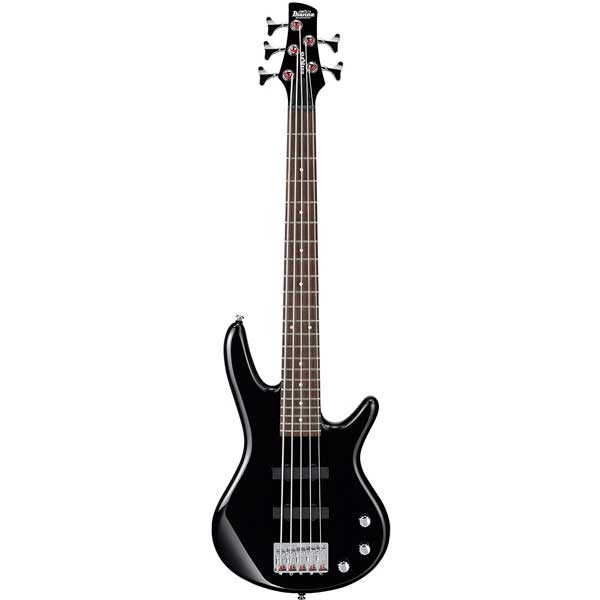
| Estimated Price | $200 |
| Materials | Poplar body, maple neck |
| Fretboard | Jatoba, 22 medium-jumbo frets |
| Pickup Configuration | 2x Standard J5 single-coil |
| Scale Length | 28.6” |
My Review: This Ibanez bass came as surprise to me considering it is a short scale five-string bass that is quite light easy to carry. It is an entry-level bass but still, it provides a wide range of tone shaping, it has a nice warm sound with a good low-end response. For the price range of course there are going to be limitations on what you can do, but still, the dual single-coil pickups will give you a lot of possibilities in different musical styles. Ibanez tried to make a bass with a little bit of everything which I think is a good thing as that is something quintessential for beginner bass players.
Key Specs and Features: The body is a smaller size according to the shorter scale neck made out of poplar which is quite light and it gives the bass a warm tone with good presence. The rounded edges of the body make it comfortable to hold and play as the bass sits nicely on the shoulders. The body has a nice gloss polyurethane finish. The thin short scale neck is made out of maple whit white dot inlays on a smooth jatoba fretboard. There are 22 medium-jumbo frets with a scale length of 28.6”. The pickup setup is two single-coil magnets, at the bridge and neck positions. It has a plastic nut and a set of Ibanez die-cast tuning machines that hold the intonation with a B15 Fixed Bridge.
Target Customer: It is an overall great beginner’s bass, with good playability, smooth neck, and design. Some experts would say shorter scale basses are more for beginners, or travel purposes, which is true. This bass is also relatively lightweight and the 5th sting adds that extra low range for the player.
Bottom Line: Great compact size makes it fit for carrying outside and using in space-restricted home studios. Sturdy and loud Ibanez GSRM25BK is a real hit for the bucks.
3. Fender Mustang PJ (Best Value)
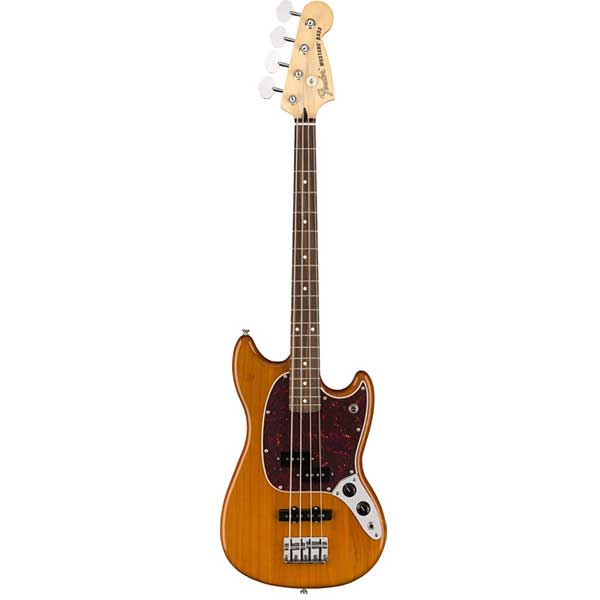
| Estimated Price | $750 |
| Materials | Alder body, maple neck |
| Fretboard | Pau Ferro |
| Pickup Configuration | Vintage Style Split-coil Pickup, Vintage Style Jazz Single-coil |
| Scale Length | 30” |
My Review: As short scale basses are gaining steam I’m sure Fender has no regrets about releasing the Mustang in 1966. The Mustang is comfortable to hold and play, sitting horizontally across the player’s body the balance of the bass is really good. The short scale gives the bass a cozy feel and the cutaway allows for a nice fingerboard approach. The bass is well set up. There are no sharp edges along the 19-fret maple neck. The satin finish and rounded C-shaped profile contribute much to the playability of the bass. With the split-coil magnets, the sound that comes out of this thing is really impressive. Mustang still offers a full punchy tone and a fair degree of sustain. The sound is warm, responsive, and great for playing precision stuff. The cool detail is that both the volume and tone controls operate across the whole turn of the pot so the bass doesn’t lose in providing a full bass tone.
Key Specs and Features: The body of the bass is a solid built made out of alder with a nice satin finish. The neck is a C-shaped bolt-on maple neck with a Pau Ferro fretboard sporting 19 medium-jumbo frets and a scale length of 30”. The neck is firmly bolted to the body and the neck pocket is very tight. There are White position markers on the front and side neck facings. The fretboard radius is 9.5”. It is equipped with P and J Bass single-coil pickups that offer that classic Precision Bass sound and vibe with a dynamically intense tone. It has a 3-way toggle switch as well as volume and tone controls. The 4-saddle standard bridge keeps intonation quite well. The hardware is in chrome.
Target Customer: Perfectly designed with its 30″ scale length, the compact dimensions are extremely comfortable for smaller players and keep the weight down for longer gigs.
Bottom Line: The bass that is extremely comfortable to play it ticks all the boxes if you’re looking for a classic vibe and has enough tonal variety for most players and musical styles. It’s a serious instrument with the hardware and fit-and-finish one would expect of any pro-level bass.
Popular Article: The Best Bass Amps Currently on the Market
4. Lakland Skyline Hollowbody-30 (Editor’s Choice)
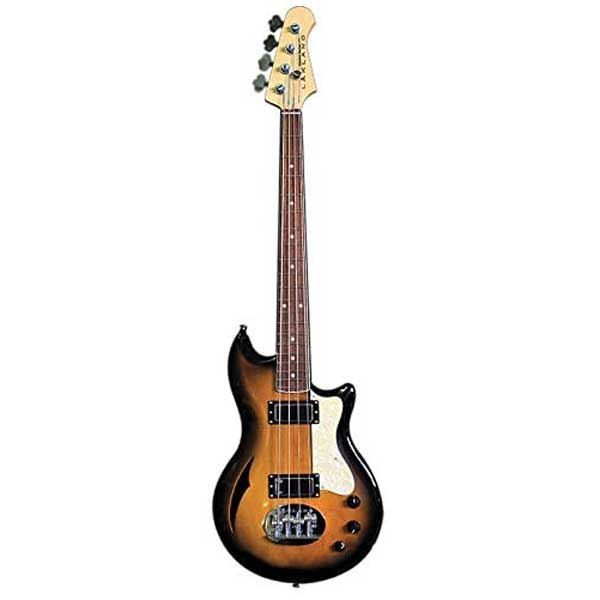
| Estimated Price | $1210 |
| Materials | Carved Mahogany back and sides with a carved Maple top, maple neck |
| Fretboard | Pau Ferro, 20 frets |
| Pickup Configuration | 2x Chi-Sonic single-coil |
| Scale Length | 30” |
My Review: I’ve been very impressed by the quality of this bass. The sound is very rich and full and the single-coil pickups have a barely noticeable amount of hum. The bass is light and balances well which is to be expected from a hollow-body bass. String tension is fantastic and the whole thing feels as solid as a rock despite being a hollow-body. A bass that plays like a dream with a nice vintage tone, the pickups give you a warm, rounded bottom, detailed mids, and a smooth natural high end. When using the neck pickup it’s a nice fat, deep sound, and then blending the bridge pickup there’s some good variety so it’s not a one-trick pony.
Key Specs and Features: The body of the bass is carved mahogany on back and sides with a carved maple top. The bass is pretty light, around 7 lbs which is awesome. The neck is a familiar J Taper design made out of maple with a Pau Ferro fretboard with 20 frets. The neck is decorated with dot inlays keeping that vintage look. The bass is equipped with the special Chi-Sonic pickups that work so damn well. You get a high output with a wide frequency response. It has a custom Lakland bridge that utilizes a through bridge stringing only. It has two volume controls and one master tone control knob.
Target Customer: This Skyline bass is perfect for experienced players who want to experiment and change things up.
Bottom Line: Lakland has produced a bass that is going to raise them even more in the bass guitar market, once again proving the quality of the instruments that come out from their shops. Price aside, I think this is the best short scale bass guitar out there right now. Buy once, cry once.
5. Gibson Les Paul Junior Tribute DC Bass (Best Under $1000)
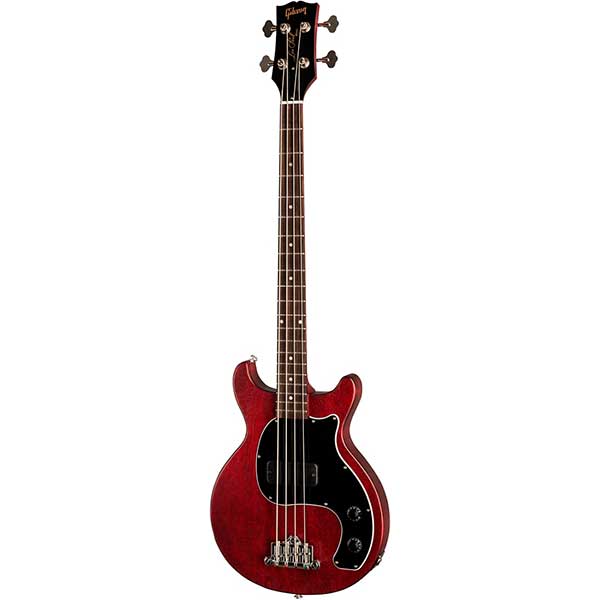
| Estimated Price | $1000 |
| Materials | Mahogany body, maple neck |
| Fretboard | Rosewood |
| Pickup Configuration | LP BassBucker |
| Scale Length | 30.5” |
My Review: As a lover of any Les Paul model, this little bass is a must for me. Les Paul Junior embraces its name as a tribute. The distinct double-cutaway body with modern elements can keep this bass a reliable and trusted part of a player’s arsenal for years. The design is rock solid. The single big BassBucker pickup is amazing. The tone of the bass is fun, different. It’s has a robust thick tone. The tone control on the Les Paul Junior Tribute gives just enough articulation and presence. I find it great playing reggae on it. With the tone rolled off playing closer to the neck gives you that fat muddy sound. Cool bass to have if you are doing studio recordings, it can leave some long-scale basses in the dust trust me.
Key Specs and Features: The bass features a mahogany body with a classic Les Paul double-cutaway design. The neck is made out of maple with a smooth rosewood fretboard and 20 frets. Acrylic dot inlays decorate the fretboard for better playability. The scale length is 30.5”. The bass is equipped with a 3-point adjustable bridge and Hipshot Ultra-Light Mini-Clover tuners that keep the bass in tune. Les Paul decided to go with a single BassBucker pickup which was a cool choice. The single humbucker has more than enough punch for this short scale killer. The controls are simple, one push-pull volume and one tone control knob. The bass comes with chrome-plated hardware.
Target Customer: If you are playing more than 3 sets a night this little thing can be a lifesaver. Or if you love recording at your home studio this is a bass you can do a lot with.
Bottom Line: There are a lot of styles and approaches in which this bass can fare nicely. It is a solid instrument that carries that Les Paul vibes with style.
Popular Article: The Best Guitar Tuners Out There Right Now
6. Gretsch G2220 Junior Jet II (Best Under $500)
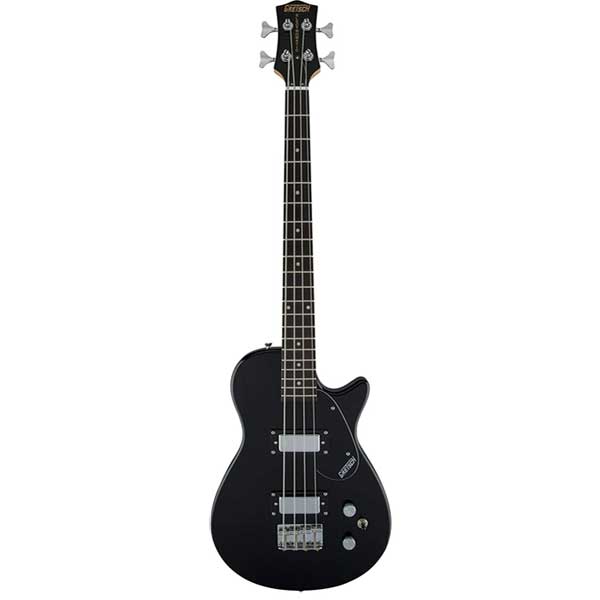
| Estimated Price | $300 |
| Materials | Basswood body, maple neck |
| Fretboard | Rosewood, 20 medium-jumbo frets |
| Pickup Configuration | 2x Gretsch mini humbucker |
| Scale Length | 28” |
My Review: The thing that surprised me about the Gretsch G2220 Junior Jet II Bass is the versatility. You can comfortably play different music styles. The tone you get out of it is perfect for precision work as well as smooth bass lines. The general perception is that short scale instruments, especially basses, sacrifice some tone for comfort and playability but that is not the case here. The tone from both pickups is clear and bright, the passive pickups do a reasonable job of conveying the tone of the instrument. It has just enough of fatness and punch. It provides plenty of vintage sounds that work well in rock as they do with many other modern genres that require a little retro feel on that low-end.
Key Specs and Features: The single-cutaway body shape is made out of basswood. The black gloss-finish fits perfectly with the D-shaped, sleek, and slinky maple neck. It’s easy to navigate, and the set-up is generally very good with no sharp fret ends. The neck is a shorter scale that features a rosewood fretboard with 20 well-placed medium jumbo frets and a Jet style headstock. It comes with a vintage bridge that sports a set of four fully adjustable saddles. All the hardware is chromed, the tuners are accurate and the bridge holds intonation quite well. It has a set of Gretsch mini-humbuckers with a chrome cover on each one. This gives the bass some character. Basic controls, master volume knob, and a tone control knob.
Target Customer: For people who like a simple instrument without all the bells and whistles and are looking for an equally simple tone without too much fuss, the Junior Jet II is not going to disappoint. For those bassists that like some soulful grooves this may tick your boxes.
Bottom Line: Solidly built, solid tone, comfort, playability. If you’re looking for a decent bass with surprisingly good sound but and don’t have much money to work with this bass gives you plenty of bang for your buck. In my opinion, this is the best short scale bass under $500 right now (number 2 on this list is also a great option).
7. Epiphone EB-0

| Estimated Price | $270 |
| Materials | Mahogany body/neck |
| Fretboard | Rosewood |
| Pickup Configuration | Single Sidewinder humbucker |
| Scale Length | 30.5” |
My Review: The Epiphone EB-0 is a nice little bass guitar. I liked it as someone accustomed to playing acoustic and electric guitars, the short scale makes it easier to play. The tone it produces is super rich and I found it great when recording stuff. It has a nice 60’s sound, which I find attractive. I find it remarkable that the price of the bass is so reasonable compared to the quality. Sounds good in blues, country, and rock and is bombproof.
Key Specs and Features: The body is the recognizable shape of Epiphone, the body is made out of mahogany that provides really good sustain. The interesting part is that the neck is also made out of mahogany which is a decision worthy of respect. The SlimTapper D profile bolt-on neck has a standard rosewood fretboard with pearl dot inlays. The 30.5” scale neck is easy to play and has a good range of tones which makes it easier to navigate the fretboard. It is perfect for beginners and players with smaller hands. The bridge is a fully adjustable three-point Tune-O-Matic style piece bridge. It keeps the intonation quite well. The pickup configuration is a little different than the rest as it has a single humbucker in the neck position. With this configuration, the bass has a fat warm sound. It is equipped with simple controls, a single tone, and a volume knob.
Target Customer: If you are looking for a great starter instrument this is it. Also if you are an experienced bassist you can try it out. Great bass for a beginner that doesn’t want to spend a lot on a bass. Very cool bass for players that want to transition from guitar to bass.
Bottom Line: With Epiphone EB-0 you get a lot of bass for the price. The bass is solid built, good for traveling and gigging, and also for practicing at home. Epiphone is no stranger when it comes to great bass guitars in the affordable segment of the market.
8. Eastwood Airline Map Bass
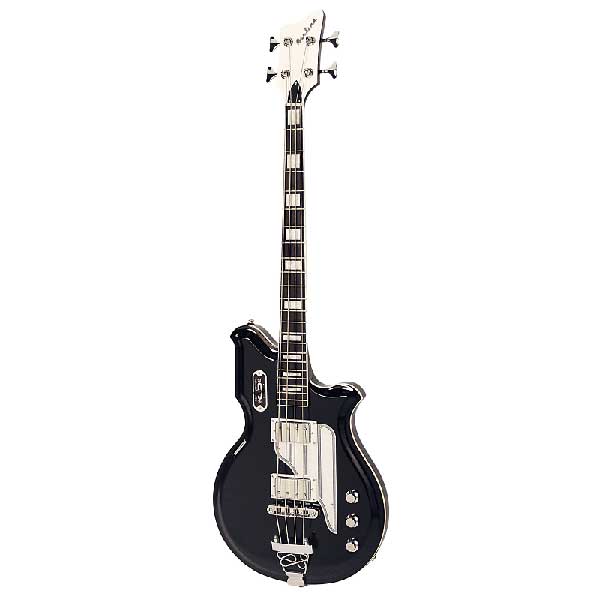
| Estimated Price | $1000 |
| Materials | Mahogany body, maple neck |
| Fretboard | Rosewood |
| Pickup Configuration | 2x Alnico Hot-10 humbuckers |
| Scale Length | 30.5” |
My Review: I was intrigued the instant I saw an ad for Eastwood’s Airline Map bass. It just looks so retro with an interesting body shape and cool finish. The finish is smooth, shiny, and deep and the neck fits the body just perfectly. Even though the shape of the bass is odd, to say the least, the bass is quite balanced and pretty light. The bass is certainly easy on the shoulders as it weighs just under 9 pounds. The sound is full and round with an emphasis on the low-end. The bridge pickup sounds bright and clear. It’s awesome for funk, blues, and R&B music. Not a bass to slap a lot, I find it performs better with finger techniques.
Key Specs and Features: The body of the bass is made out of mahogany sporting a retro design. It comes in finishes such as black, seafoam green, and white. The neck is bolt-on made out of bound maple with a rosewood fretboard and block inlays. The most unique feature on the bass is the National Style Striped Pickguard which I love. This pickguard gives the bass that retro smooth feel. It is equipped with a Tune-o-Matic bridge with a trapeze tail that holds the bass in tune good. Two Alnico Hot-10 Humbuckers at the bridge and neck positions are in charge of providing the fat low-end of the bass. It has a 3-way pickup switch control with two volume controls and tone control. The controls along with the pickups bring out the vintage design even more.
Target Customer: The Eastwood Arline Map bass is perfect for advanced players that love to play those Motown bass lines. If you are a pocket funky player this bass is more than good enough.
Bottom Line: A funky short scale, perfect for playing fat grooves. The quality and the design give the bass a distinctive retro feel. It’s the perfect bass for gigs that require maximum grooviness.
Popular Related Article: Our Favorite Acoustic Bass Guitars
9. Dean EVO XM Bass
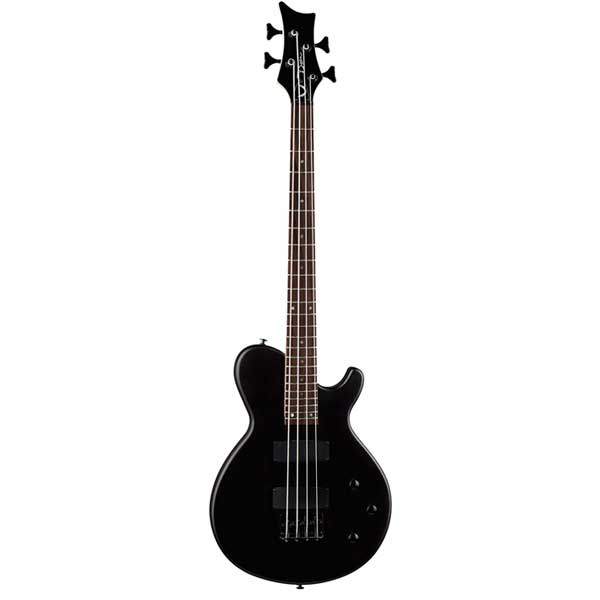
| Estimated Price | $220 |
| Materials | Mahogany body, maple neck |
| Fretboard | Walnut, 24 frets |
| Pickup Configuration | 2x DMT humbucker |
| Scale Length | 30” |
My Review: The pure performance of this little axe is what caught my attention. Almost everything was better than expected, the two humbucking pickups have enough punch and the natural mahogany finish of the bass is so smooth. In my opinion, the warm tone is perfect for blues and rock music, with the simple tone controls you can meld the tone the way you want. It is thick, warm, and all kinds of groovy. The low tones and the high tones are equally expressive.
Key Specs and Features: The design of this bass is not meant to be attractive, but simple and effective. Some people dislike it but in my opinion, it’s cool in its minimalistic way. The top wing of the guitar is larger than the bottom. The body is made out of mahogany with a flat top giving it wonderful resonance and fat lower tones, which is a must-have quality in a bass guitar. The smooth and finely tuned bolt-on C-shaped neck is made from maple and it features a fingerboard made from walnut and vintage abalone dot inlays with 24 frets. The hardware is a standard vintage-style bridge with four fully adjustable saddles and a set of die-cast tuning machines on the headstock. The bass is equipped with two DMT designed humbuckers that allow the bass to be responsive and highly adaptable to different styles of music. The controls are quite basic and come in the form of a volume and treble controls.
Target Customer: This is a great practice bass for beginners who need an inexpensive setup. It is very affordable and made for long playing sessions without compromising on sound quality or your overall experience and also if you are transitioning from guitar to bass this little thing can prove to be a good start.
Bottom Line: The Dean EVO XM bass sounds great, and it’s well built and sturdy considering its short scale. It is offered at a very affordable price range a true bang for the buck bass guitar. For all the beginner musicians looking to buy the first musical instrument, this can be a perfect pick.
10. Jackson JS1X Concert Bass Minion
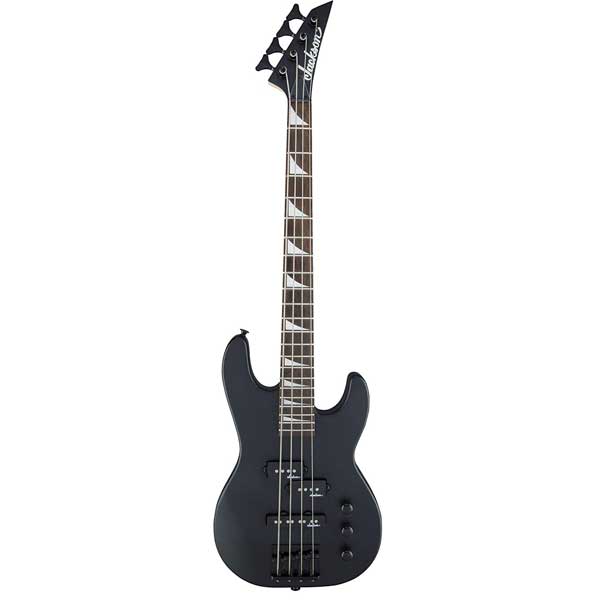
| Estimated Price | $200 |
| Materials | Mahogany body, maple neck |
| Fretboard | Walnut, 22 jumbo frets |
| Pickup Configuration | 2x DMT humbucker |
| Scale Length | 28.6” |
My Review: The bass that got me intrigued was the Jackson JS1X Concerts Minion and the first impressions were great! The curvy body design and nicely balanced weight were to be expected from a Jackson bass. For an affordable price, you get your fill of bass that you can shred with. It feels versatile and able to perform in different styles of music but the one style it was best suited for is metal. It just performs the best in metal and rock, and that is to be expected from a Jackson bass. The jumbo frets are a great feature for beginners just starting to find their way around the instrument. I’m sad I didn’t have this bass when I was a young metal shredder.
Key Specs and Features: The body is made out of softer poplar which is an economy-focused design choice Jackson keeps going back to which is cool in the affordable price range. The poplar gives the bass a fat meaty tone. Its curvy and lightweight body may not be as popular as ash or mahogany but it offers different qualities. It has a bolt-on one-piece maple neck with a 28.6” scale length with 22 jumbo frets and a fretboard made out of amaranth with a 12” radius and Pearloid sharkfin inlays. The neck has a smooth satin finish and is equipped with a graphite-reinforced rod and scarf joint. The bass is fitted with a P/J pickup configuration that performs well. It has one single-coil at the bridge and a split-coil pickup at the neck. It has simple controls, bridge and neck volume controls, and a master ton knob. It has a hardtail bridge with individual saddles that along with the tuning machines that are Jackson-designed hold up tuning quite well.
Target Customer: The Jackson JS1X is a bass that will make beginners want to pick it up and practice and slowly turn them into shredders. For people who like to rock or those who want to get into playing that funky music, it can deliver.
Bottom Line: An excellent, affordable short scale bass that is made for little shredders, it can bring out the rock star in you. The JS1X bass emerges as one of the most affordable and versatile offerings you can find in the short scale bass marker.
Related Article: Great Bass Guitars for Beginners
11. Squier by Fender Bronco Bass
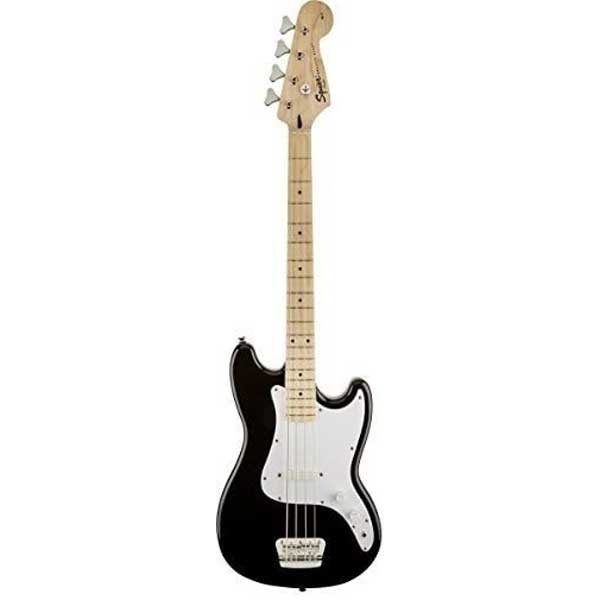
| Estimated Price | $200 |
| Materials | Agathis body, maple neck |
| Fretboard | Maple, 19 frets |
| Pickup Configuration | Single-coil magnet |
| Scale Length | 30” |
My Review: I didn’t expect the punch this bass can deliver with its single-coil magnet. This bass can do well in a lot of different styles of music with its warm and rich tone, it can carry the low end quite well, of course, you can’t expect the depth of a P-bass, but it certainly proves its worth.
Key Specs and Features: For a cheaper bass I’m really surprised how sturdy it is, the body is double-cutaway made from solid agathis and it’s quite light, the neck is slim C-shape made out of one-piece maple with a satin finish that provides a solid tone and is very comfortable to play. As it’s a short scale (30”) it lacks the depth of long-scale basses, and the sound it produces is less wiry. The fretboard is also made from maple and it has 19 medium jumbo frets which are good for beginners, the radius of the fretboard is 9.5”. As expected from a short scale bass, sacrificing the range of notes for a lighter and more playable instrument. It has just one specially designed single-coil magnet that shapes the sound of the bass with the passive setup. With the 2-saddle chrome bridge, tuning on the bass holds up fine as long as you don’t start digging in too much. It contains two knurled dome control knobs, a master volume knob, and a master tone knob similar to a P-bass. All of the hardware is in chrome finish.
Target Customer: A good buy for beginner bassists, the shorter scale provides easier playability, its perfect if you want to jam or practice. Also if you are a little bit smaller built or have smaller hands it’s a good pick for you, also a good start if you are transitioning from guitar to bass.
Bottom Line: As far as simplicity goes you can’t go much farther than this bass, less hardware fewer problems, keep it simple and groovy. A bass anyone can play, for 200$ you get your money’s worth.
Popular Article: Headless Guitars You Need to Know About
12. Danelectro Longhorn
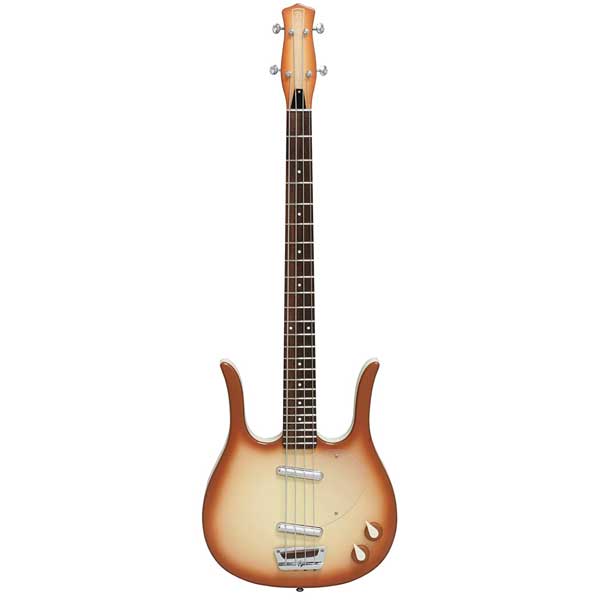
| Estimated Price | $570 |
| Materials | Alder body, maple neck |
| Fretboard | Pau Ferro, 24 frets |
| Pickup Configuration | 2x Danelectro Lipstick pickup |
| Scale Length | 29.75” |
My Review: The Danelectro Longhorn Bass is a short scale bass guitar with an interesting not so commonly seen design. Playing the Longhorn Bass I was pleasantly surprised how the instrument can deliver low deep driving notes as well as warmer higher notes. It can perform in a wide range of tonal possibilities which is neat. The bass is quite versatile and playable. The two high output pickups deliver a rich punchy tone and the addition of double-stacked controls also add to the spectrum of sounds that can be experimented with. The Longhorn Bass is one of the heavier short scale bass guitars available in the market which is not great but still lighter than the long-scale basses. This may turn some away from purchasing especially those who play live music.
Key Specs and Features: This short scale bass guitar features a slick black alder wood tonewood and the body of the guitar is shaped with a distinctive horn. The alder tonewood makes the sound characteristics of the Longhorn bass very clear and versatile. Deep horn cutaways give you access to all higher notes on the fretboard. The neck is a C-shaped bolt-on made out of maple with a Pau Ferro fretboard with classic dot inlays. The scale length of the guitar is 29.75” which is the medium range for short scale bass guitars. The Longhorn Bass comes fitted with 24 frets, providing players with access to two whole octaves. It has a traditional bridge with Pau Ferro saddles. Danelectro Lipstick pickups deliver vintage single-coil tone and bring a certain character out of the bass.
Target Customer: The price of the guitar is also in the medium range and could be a great option for beginners to move on to, or for more experienced long scale bass guitarists to experiment with. This bass is great for recording at home and showing the great design to your friends.
Bottom Line: The Danelectro Longhorn bass is certainly a classic amongst short scale bass guitars. With its unique looks, it can deliver sounds that will make you go “I didn’t expect that”.
13. Dean Edge E09M
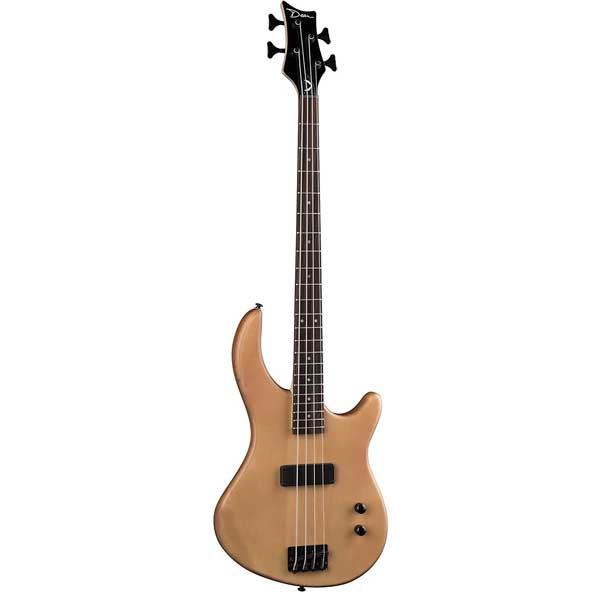
| Estimated Price | $200 |
| Materials | Basswood/mahogany body, maple neck |
| Fretboard | Rosewood, 22 frets |
| Pickup Configuration | Single soap bar pickup |
| Scale Length | 34” |
My Review: You are probably thinking why this bass made it on this list when it is a long-scale. I put it on the list just because the way the bass was built, it can pass as a short scale as it has a custom joint/heel design that makes it easier for bassists to hit those high notes. The bass has a single pickup with enough punch that is rarely seen on basses in this affordable price range. In my opinion, the warm tone is perfect for blues and rock music, with the simple tone controls you can meld the tone the way you want. It is thick, warm, and all kinds of groovy. The low tones and the high tones are equally expressive.
Key Specs and Features: The design of this bass is not meant to be attractive, but effective. Some people dislike it but in my opinion, it’s cool in its minimalistic way. The top wing of the guitar is large while the lower wing is small and short. The body is made out of basswood and mahogany giving it wonderful resonance with the lower tones of an instrument, which is a lovely quality to have in a bass guitar. The smooth and finely tuned bolt-on neck made from maple wood, featuring a fingerboard made from rosewood and vintage abalone-dotted inlays with 22 frets. The hardware is a pretty typical, standard vintage-style bridge with four fully adjustable saddles and a set of die-cast tuning machines on the headstock. The bass is equipped with Dean sourced soap-bar form passive mode pickup which allows the bass to be responsive and highly adaptable to different styles of music. The controls are quite basic and come in the form of volume and treble controls.
Target Customer: This is a great practice bass for those who need an inexpensive setup. It is very affordable and made for long playing sessions without compromising on sound quality or your overall experience.
Bottom Line: The Dean E09M Edge has good tuning, sounds great, and it’s well built and sturdy. The best part, all of this offered at a very affordable price range a true bang for the buck bass guitar. For all the beginner musicians looking to buy the first musical instrument, this can be a perfect pick.
14. Hofner Ignition Series Violin Bass
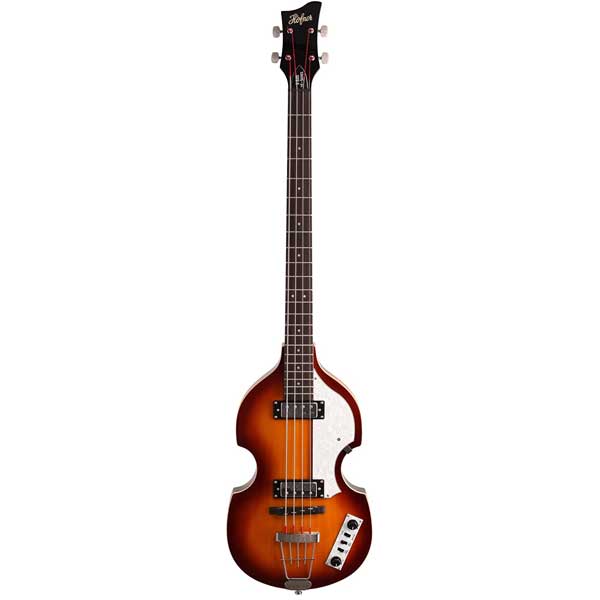
| Estimated Price | $300 |
| Materials | Alder body, maple neck |
| Fretboard | Pau Ferro, 24 frets |
| Pickup Configuration | 2x Hofner Ignition Staple Nickel humbucker |
| Scale Length | 30” |
My Review: How can you not love this vintage-inspired bass? It looks fabulous and brings a certain vintage vibe or dare I say Beatles vibe. Paul McCartney defined his playing with this vintage model. The body is lightweight, while the short scale neck feels beautiful to play and would certainly suit smaller bassists. The bass certainly delivers the vintage sound that you would expect. It great warmth and clarity that just takes you back in time.
Key Specs and Features: The designers have tried to keep as close as they could to the old vintage violin bass bringing us the slightly modern version of it. The semi-hollow body is made out of spruce on top and maple on the back. It features beautiful vintage decorations whit a nice violin sunburst finish and white binding and plastic pickguard. It has a 30” scale maple neck with a rosewood fretboard and 22 frets. Simple dot inlays decorate the fretboard. The Hofner Fretted bridge is also made out of rosewood. The bass is equipped with two Hofner Ignition Staple Nickel humbuckers at the bridge and neck position, which are fantastic at delivering the warm tones Hofner is known for. Each pickup has a volume control knob along with three switches that switch the pickups on and off. The rest of the hardware is according to its vintage looks and style.
Target Customer: For people who love to play old school music in the Beatles style this is just a must buy. It looks great and it sounds great, you can put that hat on and do those Paul McCartney bass lines.
Bottom Line: The ignition Series brings us an affordable vintage bass that meets the expectations. The quality of the craftsmanship is very admirable considering this is still an affordable bass. The playability, tone, and build quality are excellent for under $500.
Choosing the Right Short Scale Bass (Buying Guide)
This section of the article will give you information on short scale bass guitars and how to choose the right one for you.
Parts and Features
So the first thing you need to know is that the bass guitar is composed of a lot of different parts and features. Some features are more suited for different styles of music so you should choose your bass regarding the style of music you are going to play. Knowing that you are going for a short scale bass, you probably know what you are going to use it for, except if you are a beginner player who is just starting.
Body Shape and Material
You need to have a basic understanding of different body shapes and materials the body is made out of.
The shape of the bass doesn’t necessarily have a big impact on the sound but it does have an impact on the way you play and your posture, which is very important. Getting a short scale is probably the best choice when it comes to the weight of the guitar and playability. Most commonly you are going to come across solid body type basses. Made from solid pieces of wood, the solid body offers greater sustain than a hollow body guitar but is somewhat heavier. There are hollow and semi-hollow basses out there which are good, but for now, I think the best choices are solid body bass guitar.
It is very important that the shape of the guitar suits your posture and makes you feel comfortable while standing or sitting.
The body material is the next important part, not only does it matter to the sound the bass produces but also to the longevity of the instrument as some materials are lighter and prone to damage more than others that is heavier and sturdier. I prefer something that is light but has a good sound, or at least a mixture of the two. The qualities that looked in the wood are those that provide great resonance, tone, and playability. The tone the bass produces depends heavily on the density or softness of the wood. Harder woods are more aggressive and brighter sounding while softer is more resonant and warm. It all comes to personal preference at the end of the day. These days some materials are becoming more popular than others, because of their properties and low cost.
Most commonly used are maple, mahogany, poplar, basswood, alder.
Maple is quite heavy, with medium hardness and density, great sustain, and warm sound with emphasis on low-mid and lower-range tones.
Basswood has very short sustain and is quite inexpensive. More and more companies are starting to use basswood because of its price and availability.
Poplar is similar to alder in tone qualities, and thus a bit brighter. Poplar is one of the softest/lightest hardwoods of similar quality as basswood.
Mahogany is heavy, with medium hardness and density, great sustain, and warm sound with emphasis on low-mid and lower-range tones. Basses with a mahogany body can be expensive
Most P-basses are made out of alder. With a full balanced tone with excellent clarity, warm sound, alder became popular quickly in the bass guitar community.
There is also some other type of wood you can come across but these are the ones you are most likely to get your hands on. Tonewood is what makes the bass sing apart from skilled hands. With short scale basses, you don’t need to worry too much about weight but still take notice when picking the bass for yourself in terms of your physique.
Fretboard, Frets, and Nut
The next thing that you need to know is what types of neck and fretboard there are. As your fingers are going to fly over the fretboard a lot, the materials that these components are made from are important. The finish of the neck and fretboard can make a big impact on the playability of the instrument.
The role of the neck is projecting the sound from the strings into the body of the bass and the pickups as well as laying in your hand comfortably. Different systems are used to attach the neck to the body. Some are more reliable than others and some are more expensive and rarely seen on cheaper instruments.
The most common system used is the bolt-on neck system. The bolt-on is the most popular neck design. The neck is bolted onto the body with nuts keeping it in place so it doesn’t move around. This type of neck offers a great string vibration, good sustain, and great stability. Bolt-on necks are the most common type of necks found on cheap and some more expensive bass guitars.
Other systems such as set neck and thru-body neck can be found on more high-end basses. Set-necks are more reliable and better than bolt-on but also more difficult to attach. The thru-body neck is the best option that works the best but is also the most expensive one usually.
The kind of wood the bass is built from is the heart of its tone. I think that is pretty clear now. Tonewood can be tricky, sometimes you can have several guitars made from the same piece and somehow they would all behave differently. That’s why the material of the neck is very important, in combination with the body of the bass you get a lot of different variations.
The most commonly used woods for necks are maple and rosewood in my experience. While maple has a clear bright tone and is usually bright in color also, rosewood is the opposite of maple, its softness gives it a warm mellow sound.
The fretboard apart from the neck is the next important feature you need to pay attention to. The material from which the fretboard is made out, the quality of the frets and nut are the things that impact playability and the quality of the sound. Why are they important? The fretboard is the piece of wood that is glued on top of the neck and the frets that are placed on the fretboard along with the nut regulate the transfer of vibrations from the strings to the body of the bass. So when the fretboard and the frets are done in quality fashion you get a nice-sounding instrument that is comfortable to play.
The wood most commonly used for the fretboard is maple and rosewood. Rosewood is of fine quality usually brown in color and has a warm, dark tone while the maple is white and has a more percussive sound. Both of these tonewoods have distinctive properties that suit some playing styles more than others.
The frets are thin wire strips spaced at very precise intervals along the entire length of the fingerboard. Basses usually have 21, 22, or 24 frets as that depends on the scale length. basses mostly have jumbo frets. The size of the fret does impact the playability, jumbo frets for example provide better playability and sustain because it’s easier to press the strings. Along with the nut, they can make wonders for your sound or vice versa.
As it’s the point where the vibration is transferred to the wood the density of the material the nut is made of is really important. Each material has its benefits but in my experience nuts made from bone are the best ones. It’s a good thing you can replace them so you can try out different ones for yourself and see which one is best suited for your style of playing.
Scale Length and Radius
The scale length refers to the distance between the nut and the bridge. Why it’s important because it impacts the playability and the sound of the instrument in a big way. It affects the quality of the tone you get from the strings, the lower the pitch the longer the strings. The standard these days is 34” which we call “long-scale” basses but there are also short (30-32”), medium (32-34”), and extra-long (36” plus) scale basses. Not all scale lengths are the same and there aren’t any firm rules on this between bass and strings manufacturers so it’s something you should pay attention to. A lot of players have a problem with choosing their string lengths which is why you need to know your scale length.
In short, the radius is the curvature of a circle of which the small segment is equal to the width of the fingerboard. For example, a circle with a 12” radius yields a 12” fingerboard radius, which is slightly flatter than a 9.5” radius on a fingerboard of the same width, the lower the measurement, the greater the curvature, and vice versa. Why is this important? Because it impacts playability, for example, a bigger radius is better for playing single notes while a smaller one is better for chord playing.
Difference Between a Short Scale and Long Scale Bass Guitar
In the early days of electric basses, some of Fender’s competitors like Gibson sold basses with shorter scale lengths. These more finger-friendly basses are referred to as “short scale” because the scale length they have is 31″ or less.
One of the most recognizable short scale basses back in the day was the Hofner Violin bass. Designed by Walter Hofner in 1955, had a 30” scale length and a signature violin shape. Craftsmen who were working for Hofner were used to building classical instruments used their knowledge to design a bass that has that classical look to it. The Violin Bass became very popular when Paul McCartney from the Beatles started performing with it in the mid-’70s. Since then, it has remained a staple in the world of short scale basses.
In the mid-’60s Fender also entered the short scale business with the Mustang Bass, which attained a level of cult status after it went out of production in 1981. They restarted the production in 2002, but it gained steam again after Fender released a version in its Squier line in 2011. Since then it has remained in Fender’s permanent line-up with several configurations. The Fender’s Bronco Bass which was released in the mid-’60s was another short scale option that never quite achieved the same reputation as the Mustang bass. The production was halted in 1981. However, the Bronco bass has recently found its way back into the bass game.
The main difference between the short scale and the bigger long-scale is that people usually so the short scale as a child instrument. That certainly dropped the short scale bass’s cool factor, turning more serious players away from them and toward long-scale basses. There was a boom in the ’60s of short scale basses but most of the instruments were poorly built, with bad electronics and hardware and that’s why many players avoided them, apart from the fact that they were aimed at the student market, so the short scale bass earned a reputation as an instrument for children.
But now the short scale bass guitar is back and cooler than ever. More and more players are choosing to go for the smaller basses that are equally built with quality parts and have a great sound like their bigger counterparts.
Why Choose a Short Scale Bass
The first and most obvious reason to use a short scale bass is its physical size. With their shorter necks, less distance between frets, and more compact general dimensions, short scale basses are an excellent choice for players with smaller hands. If you are a guitar player who wants to explore the bass they are perfect since their short scale makes it feel like you are playing something in-between a bass and a guitar thus making the transition easier. However, you would choose an instrument just because of its size. One of the main things regarding the short scale basses is the massive sound with a fat low-end you can get. Serious players and studio pros have long known this secret about short scale basses.
A simple example of how the short scale behaves differently than a long-scale, each note played on bass includes a series of harmonics that are predictable ratios of that note. These harmonics give an instrument its unique tone and feel so when the string length is shortened the tonal properties of those harmonics change.
This is easily demonstrated on any stringed instrument. For instance, play an E on the 12th fret of the low E string. Then, play the same note on the 7th fret of the A string. While the pitches are the same, the harmonics are different. The E played on the 12th fret of the low E string is darker than the E played on the A string, which is due to the shorter length of string resonating in that position. So, because of their reduced scale length, short scale basses are inherently darker and, arguably, richer in tone than long-scale basses.
Another reason to choose a short scale bass over a long-scale bass is its distinctive feel. Traditionally short scale basses were equipped with the same string sets as long-scale basses but on a short scale bass, the strings are under less tension because they are shorter. The strings have a looser, slightly “floppy” feel, which impacts the instrument’s feel, attack, sustain, and dynamics. For players looking for a tighter feel, many string manufacturers started developing strings that respond more like standard strings on a long-scale instrument. But, even with those strings, a short scale bass retains its dark tone but with a more focused low-end.
Additionally, short scale basses let you employ techniques that are difficult to pull off on long-scale basses. As the neck is more compact long stretches between notes that are far away are more manageable. The compact fingerboard is great for speedy, 16note-filled bass lines. Playing full chords is also much easier and poses no problem. Because of the more relaxed strings, you can bend the strings on a short scale bass without crippling your fingers. All of this combined makes the short scale playable and much wanted in the bass world.
Versatility and Playability of the Short Scale
The thing that can surprise you when getting a short scale guitar is how much can be done with it. People probably think that you are limited with the shorter scale which is true in some way but in some other aspects, it can be a blessing.
If you are a beginner bass player a short scale is a must. It is just more convenient to play and to learn your way around the fretboard. As a young kid when I started playing I always struggled with long scale basses even thou I have big hands. Practicing would be challenging on five-string bass guitars just because of the size and length of the neck. It certainly paid off in my case because I managed to learn how to mute the strings more effectively when playing precise stuff but still practicing wasn’t as easy and fluid as it can be on a short scale. Doing long gigs with a short scale is a piece of cake. When you have that little bit of extra weight taken off it means so much.
You can comfortably play different music styles. You are somewhat limited in terms of soloing but if you are a groove head it has enough notes to suffice your expectations especially if you get a five-string. Transitioning to a 34” long-scale bass after playing a short scale can only make you love playing more, you’ll feel it as an upgrade.
Traveling with a short scale
In terms of transport and traveling it is much easier with a shorter scale. As a traveling musician, I always struggled to carry my big hard case with my big ass bass in it. When I got a short scale bass I felt like carrying a toy or a regular electric guitar. It comes much easier traveling especially if you are always going from one place to the next with a lot of equipment.

My name is Chris and I’ve had a passion for music and guitars for as long as I can remember. I started this website with some of my friends who are musicians, music teachers, gear heads, and music enthusiasts so we could provide high-quality guitar and music-related content.
I’ve been playing guitar since I was 13 years old and am an avid collector. Amps, pedals, guitars, bass, drums, microphones, studio, and recording gear, I love it all.
I was born and raised in Western Pennsylvania. My background is in Electrical Engineering, earning a Bachelor’s degree from Youngstown State University. With my engineering experience, I’ve developed as a designer of guitar amplifiers and effects. A true passion of mine, I’ve designed, built, and repaired a wide range of guitar amps and electronics. Here at the Guitar Lobby, our aim is to share our passion for Music and gear with the rest of the music community.

HI Christopher, many thanks for this article! I used to play guitar, then took up Tenor Sax and I recently got invited to play bass guitar. Someone lent me an old (and cheap) bass guitar to practice on. I’ve learned more about the role of the bass guitarist and some simple rhythmes and chord arpeggios. But I’m struggling with the ‘reach’ and with the ‘action’. I’d read something about ‘short-scale’ guitars which sound ideal for me. Your in-depth comparison and review will help me enornously in buying a bass guitar that suits both me and my budget.
Correction: Paul McCartney of The Beatles began playing the Hofner Violin bass in the early-mid 1960’s, NOT 1970’s! The decade in question may be a trivial fact to the up-and-coming younger generations who now rule the world of rock, but for older folks who grew during those years and knew, “Beatlemania”, the error is almost heresy!
Two short scale bases available at stores in 2023.
Cordoba’s has two versions of their 24″ scale length Acoustic/Electric Bass Guitar.
Mitchell’s 24″ scale length Acoustic/Electric Bass Guitar is also available.
These Short Scale basses are relatively inexpensive, under $300, I believe, and Cordoba products are generally well made. If you have small hands, these two instruments may be your best bet at feeling comfortable with the bass guitar.
Another option is the Bass Ukulele, with its hollow rubber strings.
Enjoy